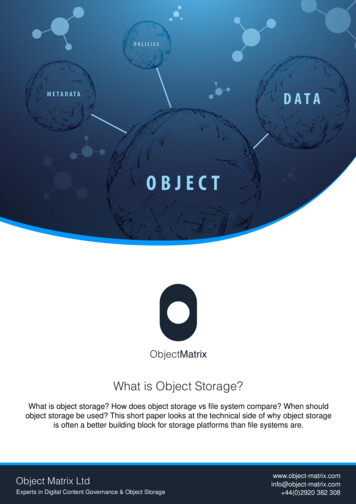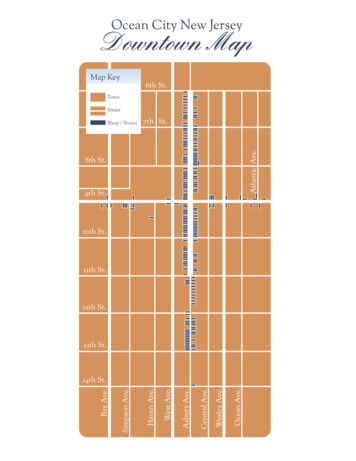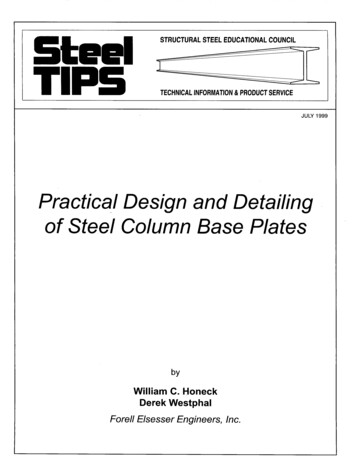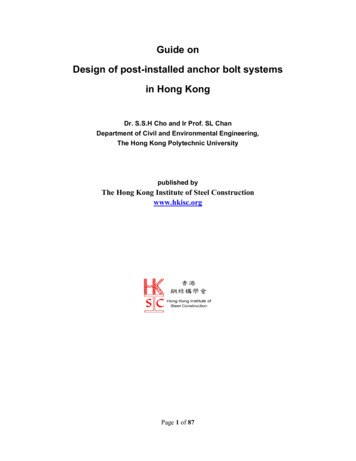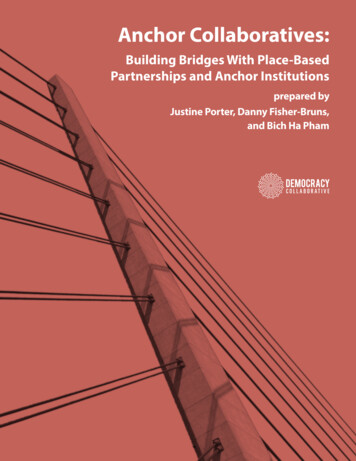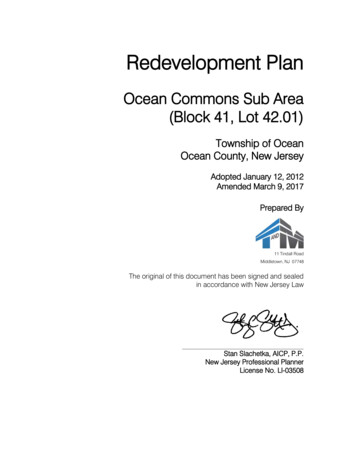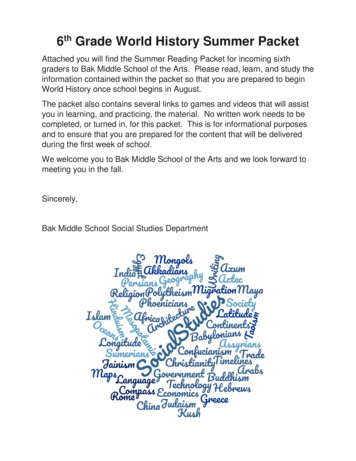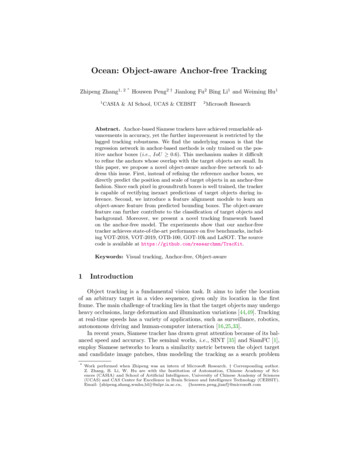
Transcription
Ocean: Object-aware Anchor-free TrackingZhipeng Zhang1, 21 Houwen Peng2 † Jianlong Fu2 Bing Li1 and Weiming Hu1CASIA & AI School, UCAS & CEBSIT2Microsoft ResearchAbstract. Anchor-based Siamese trackers have achieved remarkable advancements in accuracy, yet the further improvement is restricted by thelagged tracking robustness. We find the underlying reason is that theregression network in anchor-based methods is only trained on the positive anchor boxes (i.e., IoU 0.6). This mechanism makes it difficultto refine the anchors whose overlap with the target objects are small. Inthis paper, we propose a novel object-aware anchor-free network to address this issue. First, instead of refining the reference anchor boxes, wedirectly predict the position and scale of target objects in an anchor-freefashion. Since each pixel in groundtruth boxes is well trained, the trackeris capable of rectifying inexact predictions of target objects during inference. Second, we introduce a feature alignment module to learn anobject-aware feature from predicted bounding boxes. The object-awarefeature can further contribute to the classification of target objects andbackground. Moreover, we present a novel tracking framework basedon the anchor-free model. The experiments show that our anchor-freetracker achieves state-of-the-art performance on five benchmarks, including VOT-2018, VOT-2019, OTB-100, GOT-10k and LaSOT. The sourcecode is available at https://github.com/researchmm/TracKit.Keywords: Visual tracking, Anchor-free, Object-aware1IntroductionObject tracking is a fundamental vision task. It aims to infer the locationof an arbitrary target in a video sequence, given only its location in the firstframe. The main challenge of tracking lies in that the target objects may undergoheavy occlusions, large deformation and illumination variations [44,49]. Trackingat real-time speeds has a variety of applications, such as surveillance, robotics,autonomous driving and human-computer interaction [16,25,33].In recent years, Siamese tracker has drawn great attention because of its balanced speed and accuracy. The seminal works, i.e., SINT [35] and SiamFC [1],employ Siamese networks to learn a similarity metric between the object targetand candidate image patches, thus modeling the tracking as a search problem Work performed when Zhipeng was an intern of Microsoft Research. † Corresponding author.Z. Zhang, B. Li, W. Hu are with the Institution of Automation, Chinese Academy of Sciences (CASIA) and School of Artificial Intelligence, University of Chinese Academy of Sciences(UCAS) and CAS Center for Excellence in Brain Science and Intelligence Technology (CEBSIT).Email: g,jianf}@microsoft.com
2 7 K H 3 H U I R P D Q F H vs. 6 S H H G R Q 9 2 7 2 X U V R I I O L Q H 2 X U V R Q O L Q H 2 X U V R I I O L Q H ( 2Fig. 1. A comparison of the performance and speed of state-of-the-arttracking methods on VOT-2018. We visualize the Expected Average Overlap(EAO) with respect to the Frames-PerSeconds (FPS). Offline-1 and Offline2 indicate the proposed offline trackers with and without feature alignmentmodule, respectively. ' L 0 3 7 2 0 6 L D P 5 3 1 ' D 6 L D P 5 3 1 6 L D P 9 * * 5 H D O W L P H O L Q H & 5 3 1 7 U D F N L Q J 6 S H H G ) 3 6 of the target over the entire image. A large amount of follow-up Siamese trackers have been proposed and achieved promising performances [9,11,21,22,50].Among them, the Siamese region proposal networks, dubbed SiamRPN [22],is representative. It introduces region proposal networks [31], which consist ofa classification network for foreground-background estimation and a regressionnetwork for anchor-box refinement, i.e., learning 2D offsets to the predefinedanchor boxes. This anchor-based trackers have shown tremendous potential intracking accuracy. However, since the regression network is only trained on thepositive anchor boxes (i.e., IoU 0.6), it is difficult to refine the anchors whoseoverlap with the target objects are small. This will cause tracking failures especially when the classification results are not reliable. For instance, due to theerror accumulation in tracking, the predictions of target positions may becomeunreliable, e.g., IoU 0.3. The regression network is incapable of rectifyingthis weak prediction because it is previously unseen in the training set. As aconsequence, the tracker gradually drifts in subsequent frames.It is natural to throw a question: can we design a bounding-box regressorwith the capability of rectifying inaccurate predictions? In this work, we showthe answer is affirmative by proposing a novel object-aware anchor-free tracker.Instead of predicting the small offsets of anchor boxes, our object-aware anchorfree tracker directly regresses the positions of target objects in a video frame.More specifically, the proposed tracker consists of two components: an objectaware classification network and a bounding-box regression network. The classification is in charge of determining whether a region belongs to foreground orbackground, while the regression aims to predict the distances from each pixelwithin the target objects to the four sides of the groundtruth bounding boxes.Since each pixel in the groundtruth box is well trained, the regression networkis able to localize the target object even when only a small region is identified asthe foreground. Eventually, during inference, the tracker is capable of rectifyingthe weak predictions whose overlap with the target objects are small.When the regression network predicts a more accurate bounding box (e.g.,rectifying weak predictions), the corresponding features can in turn help the classification of foreground and background. We use the predicted bounding box as areference to learn an object-aware feature for classification. More concretely, we
Ocean: Object-aware Anchor-free Tracking3introduce a feature alignment module, which contains a 2D spatial transformation to align the feature sampling locations with predicted bounding boxes (i.e.,regions of candidate objects). This module guarantees the sampling is specifiedwithin the predicted regions, accommodating to the changes of object scale andposition. Consequently, the learned features are more discriminative and reliablefor classification.The effectiveness of the proposed framework is verified on five benchmarks:VOT-2018 [17], VOT-2019 [18], OTB-100 [44], GOT-10k [14] and LaSOT [8].Our approach achieves state-of-the-art performance (an EAO of 0.467) on VOT2018 [17], while running at 58 fps, as shown in Fig. 1. It obtains up to 92.2% and12.8% relative improvements over the anchor-based methods, i.e., SiamRPN [22]and SiamRPN [21], respectively. On other datasets, the performance of ourtracker is also competitive, compared with recent state-of-the-arts. In addition,we further equip our anchor-free tracker with a plug-in online update module,and enable it to capture the appearance changes of objects during inference.The online module further enhances the tracking performance, which shows thescalability of the proposed anchor-free tracking approach.The main contributions of this work are two-fold. 1) We propose an objectaware anchor-free network based on the observation that the anchor-based methodis difficult to refine the anchors whose overlap with the target object is small.The proposed algorithm can not only rectify the imprecise bounding-box predictons, but also learn an object-aware feature to enhance the matching accuracy.2) We design a novel tracking framework by combining the proposed anchor-freenetwork with an efficient feature combination module. The proposed trackingmodel achieves state-of-the-art performance on five benchmarks while runningin real-time speeds.2Related WorkIn this section, we review the related work on anchor-free mechanism andfeature alignment in both tracking and detection, as well as briefly review recentSiamese trackers.Siamese trackers. The pioneering works, i.e., SINT [35] and SiamFC [1],employ Siamese networks to offline train a similarity metric between the objecttarget and candidate image patches. SiamRPN [22] improves it with a region proposal network, which amounts to a target-specific anchor-based detector. Withthe predefined anchor boxes, SiamRPN [22] can capture the scale changes ofobjects effectively. The follow-up studies mainly fall into two camps: designingmore powerful backbone networks [21,50] or proposing more effective proposalnetworks [9]. Although these offline Siamese trackers have achieved very promising results, their tracking robustness is still inferior to the recent state-of-the-artonline trackers, such as ATOM [4] and DiMP [2].Anchor-free mechanism. Anchor-free approaches recently became popular in object detection tasks, because of their simplicity in architectures andsuperiority in performance [7,19,36]. Different from anchor-based methods which
4estimate the offsets of anchor boxes, anchor-free mechanisms predict the location of objects in a direct way. The early anchor-free work [47] predicts theintersection over union with objects, while recent works focus on estimating thekeypoints of objects, e.g., the object center [7] and corners [19]. Another branchof anchor-free detectors [30,36] predicts the object bounding box at each pixel,without using any references, e.g., anchors or keypoints. The anchor-free mechanism in our method is inspired by, but different from that in the recent detectionalgorithm [36]. We will discuss the key differences in Sec. 3.4.Feature alignment. The alignment between visual features and referenceROIs (Regions of Interests) is vital for localization tasks, such as detection andtracking [40]. For example, ROIAlign [12] are commonly recruited in object detection to align the features with the reference anchor boxes, leading to remarkable improvements on localization precision. In visual tracking, there are also several approaches [15,41] considering the correspondence between visual featuresand candidate bounding boxes. However, these approaches only take account ofthe bounding boxes with high classification scores. If the high scores indicate thebackground regions, then the corresponding features will mislead the detectionof target objects. To address this, we propose a novel feature alignment method,in which the alignment is independent of the classification results. We samplethe visual features from the predicted bounding boxes directly, without considering the classification score, generating object-aware features. This object-awarefeatures, in turn, help the classification of foreground and background.3Object-aware Anchor-Free NetworksThis section proposes the Object-aware anchor-free networks (Ocean) for visual tracking. The network architecture consists of two components: an objectaware classification network for foreground-background probability predictionand a regression network for target scale estimation. The input features tothese two networks are generated by a shared backbone network (elaboratedin Sec. 4.1). We introduce the regression network first, followed by the classification branch, because the regression branch provides object scale informationto enhance the classification of the target object and background.3.1Anchor-free Regression NetworkRevisiting recent anchor-based trackers [21,22], we observed that the trackers drift speedily when the predicted bounding box becomes unreliable. Theunderlying reason is that, during training, these approaches only consider theanchor boxes whose IoU with groundtruth are larger than a high threshold, i.e.,IoU 0.6. Hence, these approaches lack the competence to amend the weakpredictions, e.g., the boxes whose overlap with the target are small.To remedy this issue, we introduce a novel anchor-free regression for visualtracking. It considers all the pixels in the groundtruth bounding box as thetraining samples. The core idea is to estimate the distances from each pixel
Ocean: Object-aware Anchor-free Tracking5Fig. 2. (a) Regression: the pixels in groundtruth box, i.e. the red region, are labeled asthe positive samples in training. (b) Regular-region classification: the pixels closing tothe target’s center, i.e. the red region, are labeled as the positive samples. The purplepoints indicate the sampled positions of a location in the score map. (c) Object-awareclassification: the IoU of predicted box and groundtruth box, i.e., the region with redslash lines, is used as the label during training. The cyan points represent the samplingpositions for extracting object-aware features. The yellow arrows indicate the offsetsinduced by spatial transformation. Best viewed in color.within the target object to the four sides of the groundtruth bounding box.Specifically, let B (x0 , y0 , x1 , y1 ) R4 denote the top-left and bottom-rightcorners of the groundtruth bounding box of a target object. A pixel is consideredas the regression sample if its coordinates (x, y) fall into the groundtruth box B.Hence, the labels T (l , t , r , b ) of training samples are calculated asl x x0 , t y y0 ,r x1 x, b y1 y,(1)which represent the distances from the location (x, y) to the four sides of thebounding box B, as shown in Fig. 2(a). The learning of the regression networkis through four 3 3 convolution layers with channel number of 256, followed byone 3 3 layer with channel number of 4 for predicting the distances. As shownin Fig. 3, the upper “Conv” block indicates the regression network.This anchor-free regression allows for all the pixels in the groundtruth boxduring training, thus it can predict the scale of target objects even when only asmall region is identified as foreground. Consequently, the tracker is capable ofrectifying weak predictions during inference to some extent.3.2Object-aware Classification NetworkIn prior Siamese tracking approaches [1,21,22], the classification confidenceis estimated by the feature sampled from a fixed regular region in the featuremap, e.g., the purple points in Fig. 2(b). This sampled feature depicts a fixedlocal region of the image, and it is not scalable to the change of object scale. Asa result, the classification confidence is not reliable in distinguishing the targetobject from complex background.
6To address this issue, we propose a feature alignment module to learn anobject-aware feature for classification. The alignment module transforms thefixed sampling positions of a convolution kernel to align with the predictedbounding box. Specifically, for each location (dx , dy ) in the classification map, ithas a corresponding object bounding box M (mx , my , mw , mh ) predicted bythe regression network, where mx and my denote the box center while mw andmh represent its width and height. Our goal is to estimate the classification confidence for each location (dx , dy ) by sampling features from the corresponding candidate region M . The standard 2D convolution with kernel size of k k samplesfeatures using a fixed regular grid G {( bk/2c , bk/2c), ., (bk/2c , bk/2c)},where b·c denotes the floor function. The regular grid G cannot guarantee thesampled features cover the whole content of region M .Therefore, we propose to equip the regular sampling grid G with a spatialtransformation T to convert the sampling positions from the fixed region to thepredicted region M . As shown in Fig. 2(c), the transformation T (the dashedyellow arrows) is obtained by measuring the relative direction and distance fromthe sampling positions in G (the purple points) to the positions aligned withthe predicted bounding box (the cyan points). With the new sampling positions,the object-aware feature is extracted by the feature alignment module, which isformulated asf [u] Xw[g] · x[u g t],(2)g G, t Twhere x represents the input feature map, w denotes the learned convolutionweight, u indicates a location on the feature map, and f represents the outputobject-aware feature map. The spatial transformation t T represents thedistance vector from the original regular sampling points to the new pointsaligned with the predicted bounding box. The transformation is defined asT {(mx , my ) B} {(dx , dy ) G},(3)where {(mx , my ) B} represents the sampling positions aligned with M , e.g.,the cyan points in Fig. 2(c), {(dx , dy ) G} indicates the regular sampling positions used in standard convolution, e.g., the purple points in Fig. 2(c), andB {( mw /2, mh /2), ., (mw /2, mh /2)} denotes the coordinates of the newsampling positions (e.g., the cyan points in Fig. 2(c)) relative to the box center(e.g., (mx , my )). It is worth noting that when the transformation t T isset to 0 in Eq. (2), the feature sampling mechanism is degenerated to the fixedsampling on regular points, generating the regular-region feature. The transformations of the sampling positions are adaptive to the variations of the predictedbounding boxes in video frames. Thus, the extracted object-aware feature isrobust to the changes of object scale, which is beneficial for feature matchingduring tracking. Moreover, the object-aware feature provides a global description of the candidate targets, which enables the distinguish of the object andbackground to be more reliable.
Ocean: Object-aware Anchor-free Tracking7We exploit both the object-aware feature and the regular-region feature topredict whether a region belongs to target object or image background. For theclassification based upon the object-aware feature, we apply a standard convolution with kernel size of 3 3 over f to predict the confidence po (visualized asthe “OA.Conv” block of the classification network in Fig. 3). For the classification based on the regular-region feature, four 3 3 standard convolution layerswith channel number of 256, followed by one standard 3 3 layer with channelnumber of one are performed over the regular-region feature f 0 to predict theconfidence pr (visualized as the “Conv” block of the classification network inFig. 3). Calculating the summation of the confidence po and pr obtains the finalclassification score. The object-aware feature provides a global description of thetarget, thus enhancing the matching accuracy of candiate regions. Meanwhile,the regular-region feature concentrates on local parts of images, which is robustto localize the center of target objects. The combination of the two featuresimproves the reliability of the classification network.3.3Loss FunctionTo optimize the proposed anchor-free networks, we employ IoU loss [47] andbinary cross-entropy (BCE) loss [6] to train the regression and classificationnetworks jointly. In regression, the loss is defined asXLreg ln(IoU (preg , T )),(4)iwhere preg denotes the prediction, and i indexes the training samples. In classification, the loss Lo based upon the object-aware feature f is formulated asXLo p o log(po ) (1 p o )log(1 po ),(5)jwhile the loss Lr based upon the regular-region feature f 0 is formulated asXLr p r log(pr ) (1 p r )log(1 pr ),(6)jwhere po and pr are the classification score maps computed over the object-awarefeature and regular-region feature respectively, j indexes the training samplesfor classification, and p o and p r denote the groundtruth labels. More concretely,p o is a probabilistic label, in which each value indicates the IoU between thepredicted bounding box and groundtruth, i.e., the region with red slash lines inFig. 2(c). p r is a binary label, where the pixels closing to the center of the targetare labeled as 1, i.e., the red region in Fig. 2(b), which is formulated as 1, if v c R,p r [v] (7)0, otherwise.The joint training of the entire object-aware anchor-free networks is to optimize the following objective function:L Lreg λ1 Lo λ2 Lr ,where λ1 and λ2 are the tradeoff hyperparameters.(8)
83.4Relation to Prior Anchor-Free WorkOur anchor-free mechanism shares similar spirit with recent detection methods [7,19,36] (discussed in Sec. 2). In this section, we further discuss the differences to the most related work, i.e., FCOS [36]. Both FCOS and our methodpredict the object locations directly on the image plane at pixel level. However,our work differs from FCOS [36] in two fundamental ways. 1) In FCOS [36],the training samples for the classification and regression networks are identical.Both are sampled from the positions within the groundtruth boxes. Differently,in our method, the data sampling strategies for classification and regression areasymmetric which is tailored for tracking tasks. More specifically, the classification network only considers the pixels closing to the target as positive samples(i.e., R 16 pixels), while the regression network considers all the pixels in theground-truth box as training samples. This fine-grained sampling strategy guarantees the classification network can learn a robust similarity metric for regionmatching, which is important for tracking. 2) In FCOS [36], the objectness scoreis calculated with the feature extracted from a fixed regular-region, similar tothe purple points in Fig. 2(b). By contrast, our method additionally introducean object-aware feature, which captures the global appearance of target objects.The object-aware feature aligns the sampling regions with the predicted bounding box (e.g., cyan points in Fig. 2(c)), thus it is adaptive to the scale changeof objects. The combination of the regular-region feature and the object-awarefeature allows the classification to be more reliable, as verified in Sec. 5.3.4Object-aware Anchor-Free TrackingThis section depicts the tracking algorithm building upon the proposed objectaware anchor-free networks (Ocean). It contains two parts: an offline anchor-freemodel and an online update model, as illustrated in Fig. 3.4.1FrameworkThe offline tracking is built on the object-aware anchor-free networks, consisting of three steps: feature extraction, combination and target localization.Feature extraction. Following the architecture of Siamese tracker [1], ourapproach takes an image pair as input, i.e., an exemplar image and a candidatesearch image. The exemplar image represents the object of interest, i.e., an imagepatch centered on the target object in the first frame, while the search image istypically larger and represents the search area in subsequent video frames. Bothinputs are processed by a modified ResNet-50 [13] backbone and then yield twofeature maps. More specifically, we cut off the last stage of the standard ResNet50 [13], and only retain the first fourth stages as the backbone. The first threestages share the same structure as the original ResNet-50. In the fourth stage,the convolution stride of down-sampling unit [13] is modified from 2 to 1 toincrease the spatial size of feature maps, meanwhile, all the 3 3 convolutions
Ocean: Object-aware Anchor-free Tracking9Fig. 3. Overview of the proposed tracking framework, consisting of an offline anchorfree part (top) and an online model update part (bottom). The offline tracking includes feature extraction, feature combination and target localization with object-awareanchor-free networks, as elaborated in Sec. 4.1. The plug-in online update network models the appearance changes of target objects, as detailed in Sec. 4.2. Φab indicates a3 3 convolution layer with dilation stride of a along the X-axis and b along the Y -axis.are augmented with a dilation with stride of 2 to increase the receptive fields.These modifications increase the resolution of output features, thus improvingthe feature capability on object localization [3,21].Feature combination. This step exploits a depth-wise cross-correlation operation [21] to combine the extracted features of the exemplar and search images,and generates the corresponding similarity features for the subsequent target localization. Different from the previous works performing the cross-correlationon multi-scale features [21], our method only performs over a single scale, i.e.,the last stage of the backbone. We pass the single-scale features through threeparallel dilated convolution layers [48], and then fuse the correlation featuresthrough point-wise summation, as presented in Fig. 3 (feature combination).For concreteness, the feature combination process can be formulated asXS Φab (fe ) Φab (fs )(9)abwhere fe and fs represent the features of the exemplar and search images respectively, Φab indicates a single dilated convolution layer, and denotes thecross-correlation operation [1]. The kernel size of the dilated convolution Φab isset to 3 3, while the dilation strides are set to a along the X-axis and b alongthe Y -axis. Φab also reduces the feature channels from 1024 to 256 to save computation cost. In experiments, we found that increasing the diversity of dilationscan improve the representability of features, thereby we empirically choose threedifferent dilations, whose strides are set to (a, b) {(1, 1), (1, 2), (2, 1)}. The
10convolutions with different dilations can capture the features of regions withdifferent scales, improving the scale invariance of the final combined features.Target localization. This step employs the proposed object-aware anchorfree networks to localize the target from search images. The probabilities po andpr predicted by the classification network are averaged with a weight ω aspcls ωpo (1 ω)pr .(10)Similar to [1,21], we impose a penalty on scale change to suppress the largevariation of object size and aspect ratio. We provide more details in the supplementary materials.4.2Integrating Online UpdateWe further equip the offline algorithm with an online update model. Inspiredby [2,4], we introduce an online branch to capture the appearance changes of target object during tracking. As shown in Fig. 3 (bottom part), the online branchinherits the structure and parameters from the first three stages of the backbonenetwork, i.e., modified ResNet-50 [13]. The fourth stage keep the same structureas the backbone, but its initial parameters are obtained through the pretrainingstrategy proposed in [2]. For model update, we employ the fast conjugate gadientalgorithm [2] to train online branch during inference. The foreground score mapsestimated by the online branch and the classification branch are weighted asp ω 0 ponl (1 ω 0 )p̂cls ,(11)where ω 0 represents the weights between the classification score p̂cls and theonline estimation score ponl . Note that the IoUNet in [2,4] is not used in ourmodel. We refer readers to [2,4] for more details.5ExperimentsThis section presents the results of our Ocean tracker on five tracking benchmark datasets, with comparisons to the state-of-the-art algorithms. Experimental analysis is provided to evaluate the effects of each component in our model.5.1Implementation DetailsTraining. The backbone network is initialized with the parameters pretrained on ImageNet [32]. The proposed trackers are trained on the datasetsof Youtube-BB [29], ImageNet VID [32], ImageNet DET [32], GOT-10k [14] andCOCO [26]. The size of input exemplar image is 127 127 pixels, while the searchimage is 255 255 pixels. We use synchronized SGD [20] on 8 GPUs, with eachGPU hosting 32 images, hence the mini-batch size is 256 images per iteration.There are 50 epochs in total. Each epoch uses 6 105 training pairs. For thefirst 5 epochs, we start with a warmup learning rate of 10 3 to train the objectaware anchor-free networks, while freezing the parameters of the backbone. For
Ocean: Object-aware Anchor-free Tracking11the remaining epochs, the backbone network is unfrozen, and the whole networkis trained end-to-end with a learning rate exponentially decayed from 5 10 3to 10 5 . The weight decay and momentum are set to 10 3 and 0.9, respectively.The threshold R of the classification label in Eq. (7) is set to 16 pixels. Theweight parameters λ1 and λ2 in Eq. (8) are set to 1 and 1.2, respectively.We noticed that the training settings (data selection, iterations, etc.) areoften different in recent trackers, e.g., SiamRPN [22], SiamRPN [21], ATOM[4] and DiMP [4]. It is difficult to compare different models under a unifiedtraining schedule. But for a fair comparison, we additionally evaluate our methodand SiamRPN [21] under the same training setting, as discussed in Sec. 5.3.Testing. For the offline model, tracking follows the same protocols as in[1,22]. The feature of the target object is computed once at the first frame, andthen is continuously matched to subsequent search images. The fusion weightω of the object-aware classification score in Eq. (10) is set to 0.07, while theweight ω 0 in Eq. (11) is set to 0.5. These hyper-parameters in testing are selectedwith the tracking toolkit [50], which contains an automated parameter tuningalgorithm. Our trackers are implemented using Python 3.6 and PyTorch 1.1.0.The experiments are conducted on a server with 8 Tesla V100 GPUs and a XeonE5-2690 2.60GHz CPU. Note that we run the proposed tracker three times, thestandard deviation of the performance is 0.5%, demonstrating the stability ofour model. We report the average performance of the three-time runs in thefollowing comparisons.Evaluation datasets and metrics. We use five benchmark datasets including VOT-2018 [17], VOT-2019 [18], OTB-100 [44], GOT-10k [14] and LaSOT [8]for tracking performance evaluation. In particular, VOT-2018 [17] contains 60sequences. VOT-2019 [18] is developed by replacing the 20% least challengingvideos in VOT-2018 [17]. We adopt the Expected Average Overlap (EAO) [18]which takes both accuracy (A) and robustness (R) into account to evaluateoverall performance. The standardized OTB-100 [44] benchmark consists of 100videos. Two metrics, i.e., precision
model achieves state-of-the-art performance on ve benchmarks while running in real-time speeds. 2 Related Work In this section, we review the related work on anchor-free mechanism and feature alignment in both tracking and detection, as well as brie y review recent Siamese trackers. Siamese trackers. The pioneering works, i.e., SINT [35] and .

